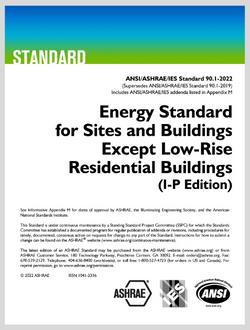ASHRAE Journal Special Series: Changes to Standard 90.1 Requirements

PURCHASE I-P VERSION PURCHASE SI VERSION
 Members Save 25%!
Members Save 25%!
“Standard 90.1 continues to adapt to the needs of the building industry and provide a cost-effective energy efficiency standard that benefits stakeholders and society as a whole.” — Don Brundage, Chair of SSPC 90.1, 2020-2023
PART 1
Changes to Envelope Requirements in ANSI/ASHRAE/IES Standard 90.1-2022
Read the article
|
The first in a series of monthly articles on the latest edition of ANSI/ASHRAE/IES Standard 90.1, Energy Standard for Sites and Buildings Except Low-Rise Residential Buildings. This month’s article will cover several changes that were introduced to the envelope requirements of Standard 90.1-2022.
|
PART 2
Thermal Bridging Requirements in ANSI/ASHRAE/IES Standard 90.1-2022
Read the article
|
By Len Sciarra, AIA, Rahul Athalye, Jonathan Humble, FAIA, Chris Mathis, Ben Meyer, Mike Tillou, P.E. and Robert Zabcick, P.E.
This article focuses on changes in Section 5, Building Envelope, related to thermal bridging in building envelopes, in ANSI/ASHRAE/IESNA Standard 90.1-2022, Energy Standard for Sites and Buildings Except Low-Rise Residential Buildings.
|
PART 3
What’s New in Standard 90.1-2022—Mechanical Updates, Part I: HVAC&R and Service Water Heating
Read the article
|
By Richard Lord, Fellow ASHRAE, and Donald Brundage, Member ASHRAE
This article describes changes to ANSI/ASHRAE/IES Standard 90.1-2022, Energy Standard for Sites and Buildings Except Low-Rise Residential Buildings with respect to the HVAC&R (Section 6) and Service Water Heating (Section 7) portions of the standard. Mechanical equipment efficiency, followed by a breakdown of the changes to the mandatory and prescriptive requirements of Section 6 and Section 7, respectively, are covered.
|
PART 4
Energy Credits—A New Way to Save In ASHRAE/IES Standard 90.1-2022
READ THE ARTICLE
|
Reid Hart, P.E., Life member ASHRAE; Doug Maddox, P.E., Member ASHRAE; Michael Tillou, P.E., Member ASHRAE; Michael Rosenberg, Fellow ASHRAE
ASHRAE/IES Standard 90.1-2022 includes a new prescriptive efficiency requirement called energy credits. These are contained in a new Section 11 that outlines the scope, credit requirements and measures available to achieve the required credits. This article puts energy credits in the context of energy savings progress for Standard 90.1, reviews the history of energy credits and types of measures available, discusses the scope and applicability to different building types and situations, shows the requirements compared to available credits and provides an implementation example.
|
PART 5
Lighting Changes in ASHRAE/IES Standard 90.1-2022
READ THE ARTICLE
|
By Michael Myer; Kelly Seeger, Associate Member ASHRAE
Many elements related to lighting were made in the 2022 edition of ANSI/ASHRAE/IES Standard 90.1, Energy Standard for Sites and Buildings Except Low-Rise Residential Buildings. The updated standard saves energy via reduced lighting power values, expanded control requirements and expansion of its scope to cover more exterior lighting applications such as walkways on campuses and parking lots that serve building occupants but that are not powered by a building electrical service. The updated standard also introduces efficiency requirements for horticultural lighting.
|
PART 6
What’s New in ASHRAE/IES Standard 90.1-2022—Mechanical Updates, Part II
Mechanical System Performance Rating Method
READ THE ARTICLE
|
By Supriya Goel, Associate Member ASHRAE; Reid Hart, P.E., Life Member ASHRAE; Michael Rosenberg, Fellow ASHRAE
ASHRAE/IES Standard 90.1-2022 introduces a new system performance approach—the Mechanical System Performance Rating Method—as a new pathway for HVAC compliance. This method and the metric developed to express the efficiency of the HVAC system—the total system performance ratio (TSPR)—are discussed here.
|
PART 7
ASHRAE/IES Standard 90.1-2022 Performance Path Changes
READ THE ARTICLE
|
By Jason Glazer, P.E., BEMP, Member ASHRAE; Maria Karpman, BEMP, Member ASHRAE; Itzhak Maor, Ph.D., P.E., Life Member ASHRAE; Michael Rosenberg, Fellow ASHRAE; Michael Tillou, P.E., Member ASHRAE; Jérémy Lerond, Associate Member ASHRAE
Many changes to the whole-building performance paths in ASHRAE/IES Standard 90.1 were made between the 2019 and 2022 versions, based on addenda that have gone through the public review process and achieved consensus. Many addressed feedback received by the Energy Cost Budget subcommittee from modelers, jurisdictions and beyond-code program administrators. Addenda included adding new appendices as well as major changes to language of the Energy Cost Budget Method (ECBM) and Performance Rating Method (PRM). This article is intended to help those familiar with the performance paths understand the major changes in the 2022 edition of ASHRAE/IES Standard 90.1, Energy Standard for Sites and Buildings Except Low-Rise Residential Buildings.
|